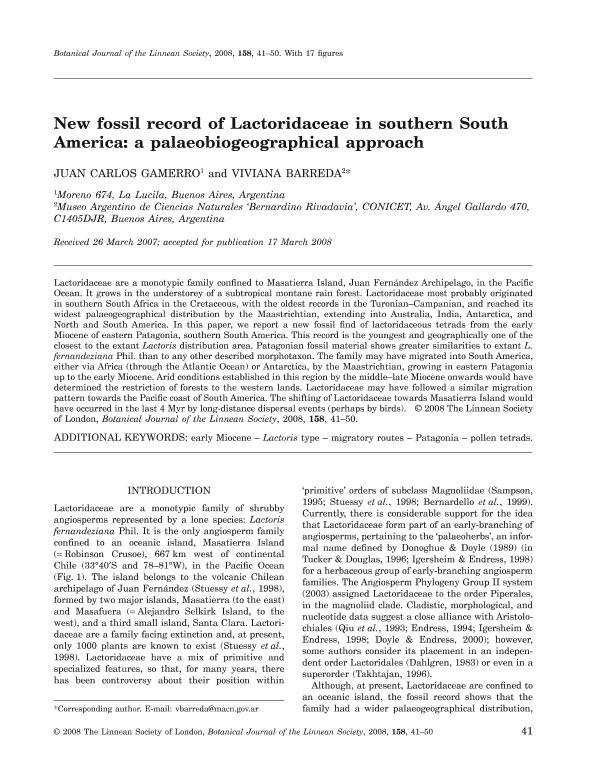Artículo
New fossil record of Lactoridaceae in southern South America: A palaeobiogeographical approach
Fecha de publicación:
09/2008
Editorial:
Wiley Blackwell Publishing, Inc
Revista:
Botanical Journal of The Linnean Society
ISSN:
0024-4074
Idioma:
Inglés
Tipo de recurso:
Artículo publicado
Clasificación temática:
Resumen
Lactoridaceae are a monotypic family confined to Masatierra Island, Juan Fernández Archipelago, in the Pacific Ocean. It grows in the understorey of a subtropical montane rain forest. Lactoridaceae most probably originated in southern South Africa in the Cretaceous, with the oldest records in the Turonian-Campanian, and reached its widest palaeogeographical distribution by the Maastrichtian, extending into Australia, India, Antarctica, and North and South America. In this paper, we report a new fossil find of lactoridaceous tetrads from the early Miocene of eastern Patagonia, southern South America. This record is the youngest and geographically one of the closest to the extant Lactoris distribution area. Patagonian fossil material shows greater similarities to extant L. fernandeziana Phil. than to any other described morphotaxon. The family may have migrated into South America, either via Africa (through the Atlantic Ocean) or Antarctica, by the Maastrichtian, growing in eastern Patagonia up to the early Miocene. Arid conditions established in this region by the middle-late Miocene onwards would have determined the restriction of forests to the western lands. Lactoridaceae may have followed a similar migration pattern towards the Pacific coast of South America. The shifting of Lactoridaceae towards Masatierra Island would have occurred in the last 4 Myr by long-distance dispersal events (perhaps by birds).
Palabras clave:
EARLY MIOCENE
,
LACTORIS TYPE
,
MIGRATORY ROUTES
,
PATAGONIA
,
POLLEN TETRADS
Archivos asociados
Licencia
Identificadores
Colecciones
Articulos(MACNBR)
Articulos de MUSEO ARG.DE CS.NAT "BERNARDINO RIVADAVIA"
Articulos de MUSEO ARG.DE CS.NAT "BERNARDINO RIVADAVIA"
Citación
Gamerro, Juan Carlos; Barreda, Viviana Dora; New fossil record of Lactoridaceae in southern South America: A palaeobiogeographical approach; Wiley Blackwell Publishing, Inc; Botanical Journal of The Linnean Society; 158; 1; 9-2008; 41-50
Compartir
Altmétricas




